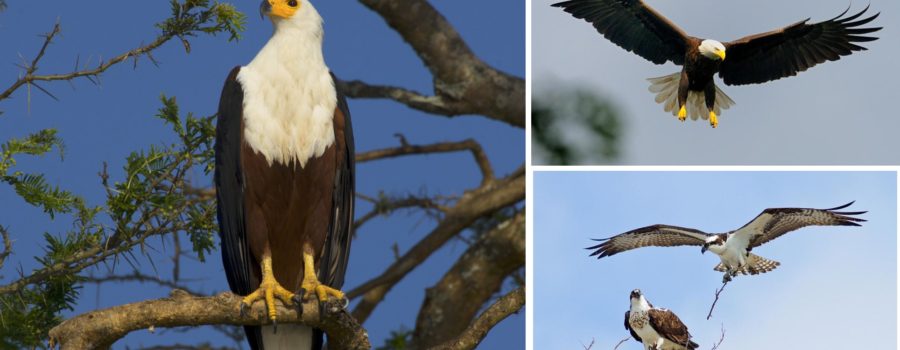In the early mornings I enjoy going downstairs before everyone else awakes, make myself coffee, and bathing in dawn’s quiet. As the sun comes up, the birds begin singing, heralding the onset of a new day.
I exercise most mornings and today was no exception. It was a running day. My usual route takes me along the Potomac River. Almost halfway through I make a 90 degree turn inland and follow a smaller quiet waterway for a couple of miles. Small songbirds are common and sometimes I see herons and other shorebirds. About two weeks ago a new visitor appeared, an osprey (photo, lower right). Ospreys, also called river hawks or fish hawks, are a fish-eating bird of prey. Brown birds with a striking white breast, they a large, up to 2 feet long with a 6 foot wingspan. Fish are almost exclusively their food source, so the bird’s sight is adapted to seeing movement below the water’s surface. Hovering 30-130 feet above the water, they ride the air currents in small circles. Suddenly plummeting feet first, almost their entire body is momentarily submerged before surfacing. If lucky, they fly to a nearby tree branch to consume their prey.
I returned from Malawi about a month ago and had seen a solitary osprey 2 or 3 times per week. I’ve watched it fish and marveled at how lucky I was to live in an urban environment yet still be so close to nature. On this morning’s run my pleasure was doubled: two of these beautiful birds were up in the air next to one another, making small circles high above the water, fishing side by side.
On this morning’s run my pleasure was doubled: two of these beautiful birds were up in the air next to one another, making small circles high above the water, fishing side by side.
My other favorite exercise is bicycling south along the Potomac down to Mt. Vernon, George Washington’s home. On the southern outskirts of town there is a golf course with three very tall dead trees adjacent to one another. Seven months ago, once or twice per week, as I rode my bike, I saw a bald eagle in one of these trees. It always chose the same branch and sat very still, surveying the world below. Bald eagles, also fish eaters, are larger than ospreys (photo, upper right). They are found only in North America and are, of course, a symbol of the United States. Even though no longer an endangered species, when seeing one it is difficult to not stop and think oneself lucky, experiencing a rare event. In my imagination, this beautiful bird was just out fishing on the nearby Potomac but chose this perfect branch on which to rest, contemplating the lesser birds flying nearby.
Malawi has its own fish-eating raptor, the African fish eagle. Similar in appearance to a bald eagle, it is found throughout sub-Saharan Africa near large bodies of fresh water (photo, left). There are many of these birds resident at Lake Malawi. Though they eat mainly fish, these birds, unlike ospreys and bald eagles, will also consume turtles, baby crocodiles, other birds, and even monkeys. The African fish eagle is the national bird of Zimbabwe and is found on the Zambian flag. One of my special memories is kayaking at sunset in the southern part of the Lake. As the sun was leaving, I stopped paddling when I saw six fish eagles on a nearby island, all in trees high above the water, near to but separated from one another.
I am unsure what attracts me to birds of prey. It may be the sound and visual beauty as they slowly flap their long wings, riding the air currents. Perhaps it is because they are at the top of their food chain. Whichever is true, once they are in my sight it is difficult to avert my gaze.






